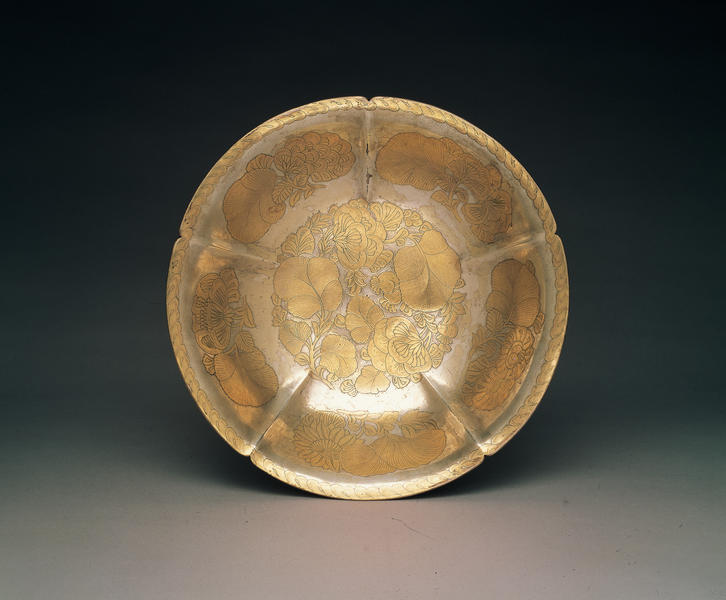Five-lobed Bowl with Foliated Rim on Foot
- China
- China, Tang period
- Late 8th to 9th centuries
- Silver gilt
- H-6.6 D-24
Catalogue Entry
Shimmering silver-gilt vessels were so esteemed in Tang China that by the early ninth century, even court historians were glad to receive these luxurious items as payment for their services.1 Aristocratic families spent vast sums of money on such items in order to display their affluence when entertaining others of their class. Their refined taste is still reflected in the sets of functional precious metal vessels including cups, bowls, and plates which survive today.
This five-lobed bowl with foliated rim was probably part of a set of dishes, which also featured lids. It is difficult to tell if this shallow silver-gilt dish was initially raised from a single sheet of metal or hammered into a shallow wooden mold.2 But after the form was created, the surface of both the interior bowl and its base, enclosed by a foot rim, were burnished, resulting in an ever so slightly perceptible concentric line pattern. A different burnishing method was utilized on the dish's exterior, resulting in a level, smooth surface.3 Then five indentations were hammered into shape from the dish's exterior, leaving five lobes and notches along the rim. The surface was then ready for decoration. The central, circular floral motif was chased, as were the five oval-shaped, scalloped-edged floral motifs surrounding it; each exterior lobe was chiseled with similar oval floral motifs. All chasing was done in continuous lines, a technique resulting in highly detailed floral patterns with minute lines resembling tiny fan spines. An overlapping petal pattern was chased around the bowl's rim; then all the dish's chased motifs were gilded. The bowl bears on its base two inscriptions indicating its weight and a character the meaning of which is unclear.4
Eight similar silver-gilt dishes, four with lids, were unearthed in Eastern Mongolia near Liaoning in 1930 and acquired by Swedish collector Orvar Karlbeck.5 The Shumei dish, reportedly one of the eight, was previously in the collection of Dr. Natanael Wessen, also of Sweden.6 Sets of five-lobed silver-gilt dishes, similar to the Shumei dish, were excavated from the Buddhist Famen Temple located near Chang'an.7
A similar five-lobed bowl, but with a central floral medallion containing two birds, was found in Lantian Xian in Shaanxi.8 Another comparable bowl, with the central floral medallion, was also excavated at Beiyin village, Shaanxi province.9 In addition, a circular not-lobed version, with similar floral motifs, was unearthed at the site at Northeastern Industrial University.10
In the West, a similar covered dish is in the University Museum at the University of Pennsylvania, a covered example is in the Seattle Art Museum collection, and two dishes are in the Pierre Uldry collection.11
JMS
1. The practice of paying court historians for their services in silver vessels as well as bolts of silk cloth began in 833; see Twitchett 1992, p. 153.
2. Technical information courtesy of Pieter Meyers and Richard H. Kimball.
3. The bowl's present flared foot-ring is not original: see Metropolitan Museum 1996, p.147.
4. Ibid., p. 147.
5. Gyllensvard 1953, p. 175.
6. Inscribed on the base inside the foot-ring in two different hands are two inscriptions referring to the weight of the bowl. The first, in the center, reads er shi wu liang (25 liang); the second reads shi san liang ba fen (13 liang, 8 fen). The meaning of a third character [?] is unclear (Metropolitan Museum 1996, p. 147).
7. Also in the Famen Temple holdings are two five-lobed ceramic bowls called mi ce ware. Featuring yellow glazed interiors and blue-black glazed exteriors, the bowls' rims and feet are edged with silver. The five exterior lobes are decorated with appliqu馘 metal medallions featuring two gold birds amid silver oval floral motifs. Dated A.D. 874, these bowls illustrate the aesthetic influence of precious metal design on porcelain. For similar metal pieces unearthed at the Famen Temple see Han 1994, pp. 106-7; for an example of a mi ce bowl see ibid., pp. 76-78.
8. Kaogu yu Wenwu 1982.1, p. 47, fig. 3.
9. Zhenjiang bowuguan Shaanxi sheng bowuguan 1985, pl. 172, fig. 173.
10. Ibid., pl. 143, fig. 144.
11. Gyllensvard 1953, p. 175, figs. 115a, 115c, pl. 115e; Uldry 1994, pls. 147-48.
